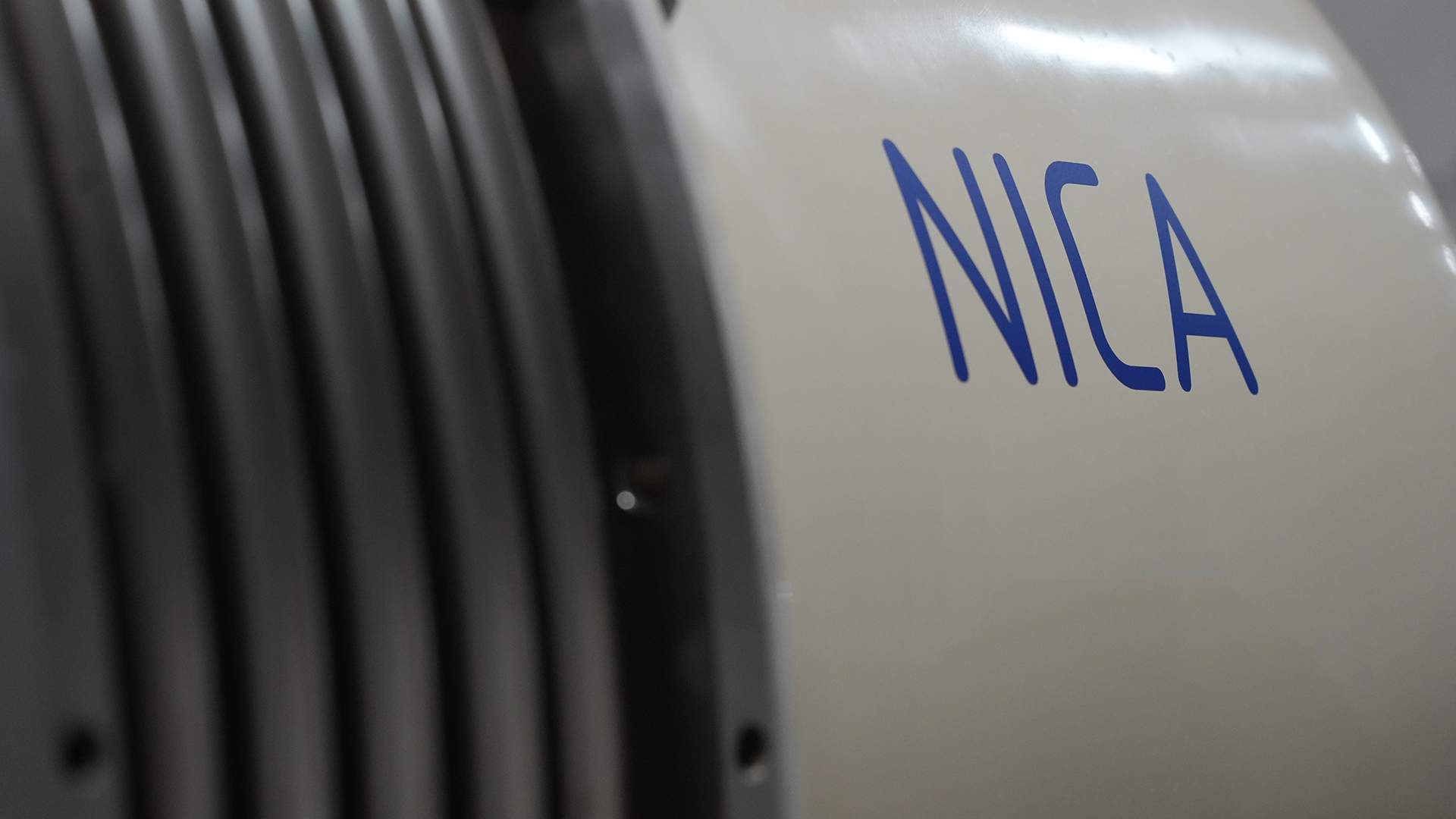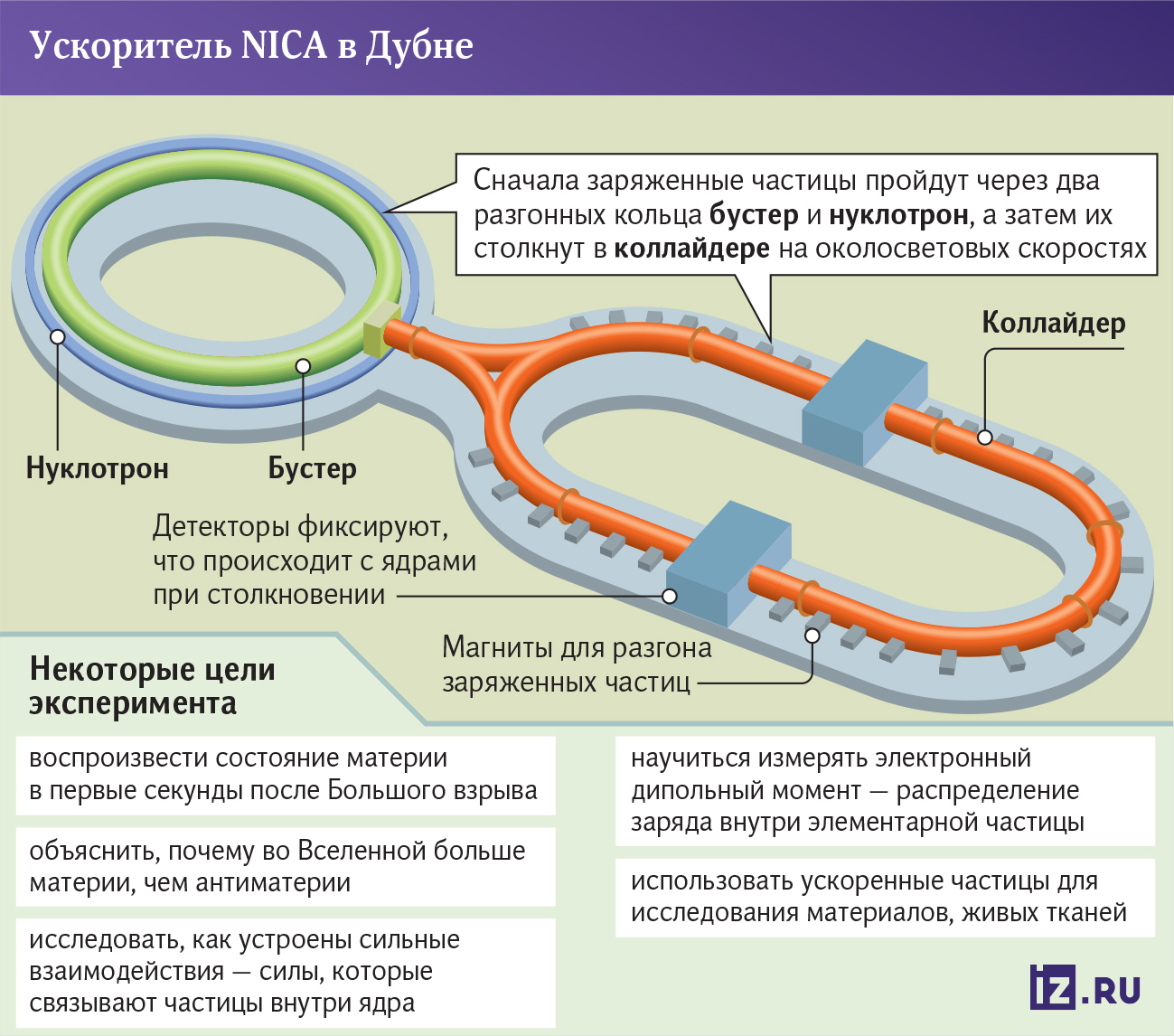- Статьи
- Science and technology
- Ion and she: secrets of the beginning of the Universe will allow the discovery of the new NICA accelerator in Dubna
Ion and she: secrets of the beginning of the Universe will allow the discovery of the new NICA accelerator in Dubna

Russia has launched the first particle acceleration session at the NICA complex, a unique scientific installation of the megascience class. The experiment will last six months. It will involve all the main elements of the complex. Thanks to this new scientific infrastructure, researchers expect to find answers to the fundamental mysteries of the universe. For example, what dark matter consists of and how the strong interactions that bind particles together inside the nucleus work. At the same time, the experts noted, NICA will become a tool for studying materials and living tissues at a new level.
How the NICA accelerator works
The first session of particle acceleration at the NICA complex marked the beginning of a cycle of research that will reveal the fundamental secrets of the universe. For example, how the universe is formed from the "bricks" of quarks and gluons. Or how the strong interactions are arranged — the most powerful and most mysterious forces of nature that bind particles inside the nucleus and are responsible for the formation of almost all matter in the universe. However, thanks to the new scientific infrastructure, researchers expect to get closer to understanding dark matter. Vladimir Kekelidze, Vice Director of the Joint Institute for Nuclear Research (JINR), told Izvestia about this.
The starting point for the deployment of research was the launch on March 25 of the first session of the NICA accelerator, which will last about six months. All the main systems of the mega-plant will be involved in the process. The experiment will end with the collision of oncoming xenon beams at their intersection point in a multi-purpose detector, one of the two basic parts of the complex.
— This is a historic moment, this is a 19-year journey. We are all waiting for the data from the first physical experiments when we see the colliding beams on the monitors in the control room. I think this moment will come in July and August," said JINR Director, Academician of the Russian Academy of Sciences Grigory Trubnikov.
As the researchers explained, NICA was built on the basis of a synchrophasotron accelerator for accelerating protons to high energies. It was built in Dubna in the 1950s. At one time, this installation was considered one of the best in the world, but over time it has lost its scientific relevance. In 2006, the physicists' proposal to develop the complex received the support of the Russian government and was included in the JINR development program. In 2016, the foundation stone of the main building of NICA was laid. More than 2,000 companies from Russia and dozens of other countries took part in the construction.
According to Vladimir Kekelidze, the NICA scientific program was adopted after extensive discussion by the world scientific community, during which truly unique tasks were identified.
— The work at NICA will not only intensify the research already underway in the world, but also expand it into areas that are not available in other world centers. For example, these are areas of extreme states of nuclear matter — its maximum possible density, which exists only in the bowels of neutron stars," the scientist explained.
He specified that NICA includes an accelerator complex, detectors, engineering and IT infrastructure, which are located in dozens of buildings. In this case, the accelerator itself consists of several ion sources, two linear accelerators, two cyclic superconducting accelerators (with a perimeter of about a quarter of a kilometer) and a number of beam transportation channels. The top of the complex is a collider (an installation where particles collide).
What experiments will be carried out at the NICA complex
According to Vladimir Kekelidze, NICA is based on the technology of cryogenic fast—cycling magnets developed at JINR. According to it, accelerators accelerate ions of various grades (from light hydrogen nuclei to heavy ones — bismuth or gold) to energies of tens of gigaelectronvolts and speeds close to the speed of light.
The heart of the complex consists of hundreds of thousands of microelectronics channels and a complex set of sensors that detect particles formed as a result of collisions of accelerated ions.
— The main scientific direction at the launch of the NICA collider is the study of heavy ion collisions and the study of the transition of nuclear matter into quark—gluon plasma in the MPD multipurpose detector. This is a state of matter with high density and temperature that existed in the first moments after the Big Bang. For these purposes, NICA has unique characteristics and perfectly complements existing experiments in the world," Yuri Senichev, a leading researcher at the Institute for Nuclear Research of the Russian Academy of Sciences, told Izvestia.
Another equally important area is the study of spin physics (spin is the intrinsic angular momentum of an elementary particle. — Approx. Izvestia), where beams of polarized light nuclei collide in the SPD detector. As a result, data will be obtained on the spin structure of nucleons, the particles that make up atomic nuclei, the scientist explained.
— The spin program significantly expands the scientific potential of NICA. So, one of the main tasks of the complex, in addition to studying the collision of polarized beams, is the study of the electric dipole moment (EDM) of light nuclei. The detection of this signal will allow us to describe the most important aspects of the evolution of our universe and will become a window into new physics," added Alexey Melnikov, a junior researcher at the Institute for Nuclear Research of the Russian Academy of Sciences.
According to him, the experiment on measuring the EDM of light nuclei on a storage ring is the first in Russia. The developed technique will improve the accuracy of EDM measurements by four orders of magnitude compared to those conducted in the world earlier.

This may be an important discovery, as finding EDM will help explain, for example, why there is more matter than antimatter in the universe, which contradicts current ideas that assume complete symmetry in the origin of matter. In addition, EDM can be sensitive to the interactions of particles with dark matter, so by learning how to measure it, you can get closer to understanding this substance, the scientist added.
"Experiments at the NICA accelerator complex are important for an in—depth understanding of new physics, which has reached its limit at such megascience facilities as the Large Hadron Collider or synchrotrons," said Mikhail Romanovsky, Director of Scientific and Technical Program Management at the private institution Science and Innovation of the Rosatom State Corporation, Deputy Director for Science of the NCFM.
For example, the expert explained, heavy particles will collide at NICA, resulting in a quark-gluon plasma. Previously, it was studied only in the collision of various relatively light particles, for example, protons. However, this is not enough to understand physics. Experiments at the accelerator will allow us to advance our understanding of the matter inside the nucleon (the particles that make up the atomic nucleus). As a result, new effects can be discovered and technologies can be further developed that will contribute to the development of alternative energy sources.
— NICA is one of the few world—class installations that have been launched in Russia for a long time. Moreover, it will solve tasks that are not covered by other accelerators existing in the world. This significantly increases the importance and scientific prestige of the country," says Nikolai Nikolaev, Professor of the Department of Problems of Theoretical Physics at the Moscow Institute of Physics and Technology, Doctor of Physico—Mathematical Sciences.
In addition, such complexes, the scientist noted, will allow the country to train a new generation of advanced scientists in various sciences. In particular, many specialized laboratories will be created around NICA, which will use accelerated particle beams to study substances and living tissues at the atomic level. These studies are necessary for obtaining new high-tech materials, medicines, chemical catalysts and other purposes, the scientist concluded.
Переведено сервисом «Яндекс Переводчик»





